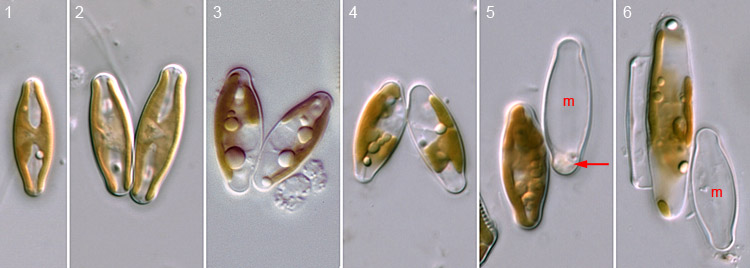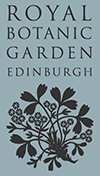Introduction
This series of photographs show stages in the sexual reproduction of Sellaphora auldreekie. Cells pair and produce one gamete apiece (Figs 2-4). Fertilization produces a single zygote lying on one of the gametangia (Fig. 5), which then expands to restore the maximum size for the species (Fig. 6). Summary of process: two small cells produce one large cell via sexual reproduction.
Detail: Vegetative cells are solitary (Fig. 1). After sexualization they pair actively and bond together, side-by-side (Fig. 2). Initially, they look exactly the same as they did during mitotic interphase (Fig. 2). As cells enter meiotic prophase, the protoplast is reorganized through movements of the chloroplast and nucleus (Fig. 3) and the nucleus expands and becomes much more obvious than at any other time during the whole life cycle. The cells are now gametangia. Slight further rearrangements of the protoplast (Fig. 4) accompany an unequal cytokinesis at the end of meiosis I. Each gametangium forms a single large gamete (Fig. 4). The thecae split apart locally in the zone where the gametangia are in contact and an aperture is formed between them (note the bulges in this region in Fig. 4). The gamete from one gametangium moves through the aperture into the other gametangium, fusing with the gamete there to form a zygote (Fig. 5), leaving behind a small residual body (Fig. 5, arrow). The donor gametangium (m) can be designated as 'male', the recipient 'female'. The zygote undergoes some internal rearrangement and constructs a special wall to form an 'auxospore', which then expands at both ends to produce an elongate, cigar-shaped cell (Fig. 6), within which a new frustule is formed. Expansion is parallel to the long axis of the female gametangium. The auxospore contains two chloroplasts, one inherited from the male gametangium, the other from the female gametangium.
This type of sexual reproduction, described by Mann (1989), is an example of Geitler's type IIB2 auxosporulation (1 gamete per gametangium; behaviourally anisogamous; lacking copulation tubes or papillae: Geitler 1973).
The photographs above were taken at various times and show different cells and cell-pairs from Blackford Pond and Lochend Loch, Edinburgh. They were taken using differential interference contrast optics, with Reichert Polyvar photomicroscopes. The gametangial cells shown are c. 25 µm long. The whole process from stages 2 to 6 occupies a couple of days.
Other pages give greater detail on stages of sexual reproduction and auxospore development in allogamous Sellaphora species, as follows:
- Pairing
- Protoplast reorganization after pairing
- Meiosis
- Gametogenesis
- Plasmogamy
- Formation and expansion of the auxospore
- Formation of the initial cell


 This site is hosted by
the Royal Botanic
Garden Edinburgh.
This site is hosted by
the Royal Botanic
Garden Edinburgh.